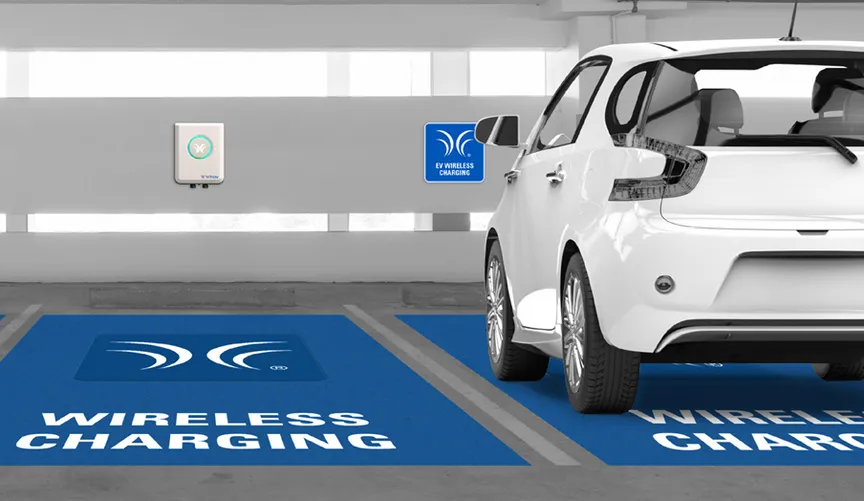The electric vehicle (EV) market is buzzing with innovation, and one of the most electrifying advancements in 2023 is wireless EV charging. Imagine a world where you can charge your car without plugging in—this is not just a vision of the future but a reality reshaping urban mobility today. According to Bloomberg Green, wireless charging technology is set to grow at a compound annual growth rate of 36% over the next five years. This article will explore how this cutting-edge technology is transforming urban landscapes, making EVs even more convenient and accessible.
The Rise of Wireless EV Charging
What is Wireless EV Charging?
Wireless EV charging, also known as inductive charging, allows electric vehicles to charge without physical connectors. This innovative technology uses electromagnetic fields to transfer energy between a charging pad on the ground and a receiver on the vehicle. Major players like Tesla, Hyundai, and BYD are investing heavily in this technology, aiming to make EV charging as simple as parking your car.
How Does Wireless Charging Work?
- Inductive Charging Pads: Installed on the ground in garages, parking lots, or even on city streets.
- Vehicle Receivers: A compatible receiver installed in the vehicle aligns with the pad.
- Magnetic Field: When aligned, a magnetic field is created, transferring energy to the car’s battery.
The efficiency of wireless charging has improved significantly, with current systems achieving up to 95% efficiency, comparable to traditional plug-in chargers, as reported by MIT Technology Review.
Benefits of Wireless EV Charging
- Convenience: No more fumbling with cables or connectors.
- Safety: Reduces the risk of tripping hazards and electrical faults.
- Aesthetic Urban Design: Removes clutter from urban environments, integrating seamlessly into the landscape.
- Enhanced Accessibility: Makes EVs more accessible for people with disabilities or those with limited mobility.
The Impact on Urban Mobility
Transforming City Infrastructure
Wireless EV charging is set to redefine urban infrastructure. Imagine streets embedded with charging pads, allowing vehicles to charge while stopping at traffic lights or parked. Cities like Oslo and London are already piloting such projects, paving the way for a seamless charging experience.
- Smart Parking Lots: Equipped with wireless charging pads, turning downtime into charging time.
- Public Transport Integration: Buses and taxis equipped with receivers can charge at designated stops, reducing downtime and emissions.
Boosting EV Adoption
One of the hurdles for EV adoption has been range anxiety and the inconvenience of charging. Wireless charging mitigates these concerns by providing more opportunities to charge seamlessly, thus encouraging more drivers to switch to electric vehicles. According to CleanTechnica, cities with wireless charging infrastructure have seen a 20% increase in EV registrations.
Practical Guide to Wireless Charging
How to Charge Wirelessly
- Check Compatibility: Ensure your EV is equipped with a wireless charging receiver.
- Locate Charging Stations: Use apps like PlugShare to find nearby wireless charging spots.
- Align and Park: Position your vehicle over the charging pad, following any alignment guides.
- Monitor Charging: Use your EV’s app or dashboard to monitor the charging process.
Where to Buy Wireless Charging Equipment
- Tesla and Hyundai: Offer factory-installed wireless charging options for select models.
- Aftermarket Solutions: Companies like WiTricity and Plugless offer retrofitting solutions for existing EVs.
What to Compare
- Charging Speed: Look for systems offering higher kW for faster charging.
- Installation Cost: Compare prices for installation at home versus public stations.
- Vehicle Compatibility: Ensure your vehicle is compatible with the charging system you choose.
Conclusion: The Future of Wireless EV Charging
Wireless EV charging is not just a technological advancement; it’s a transformative shift in how we think about urban mobility. As more cities embrace this technology, we can expect a cleaner, more efficient, and more accessible transportation ecosystem. Imagine a future where you’re never far from a charge, and your car powers up as you go about your day.
Are you ready to join the wireless revolution? Share your thoughts or experiences with wireless charging in the comments below. As we look to the future, the possibilities are endless, and the potential for wireless technology to revolutionize urban mobility is just beginning to unfold. With continued advancements and adoption, we are on the brink of a charging revolution that’s set to electrify our cities.
By embracing wireless EV charging, we are not just charging vehicles; we are charging forward toward a sustainable and innovative future.

